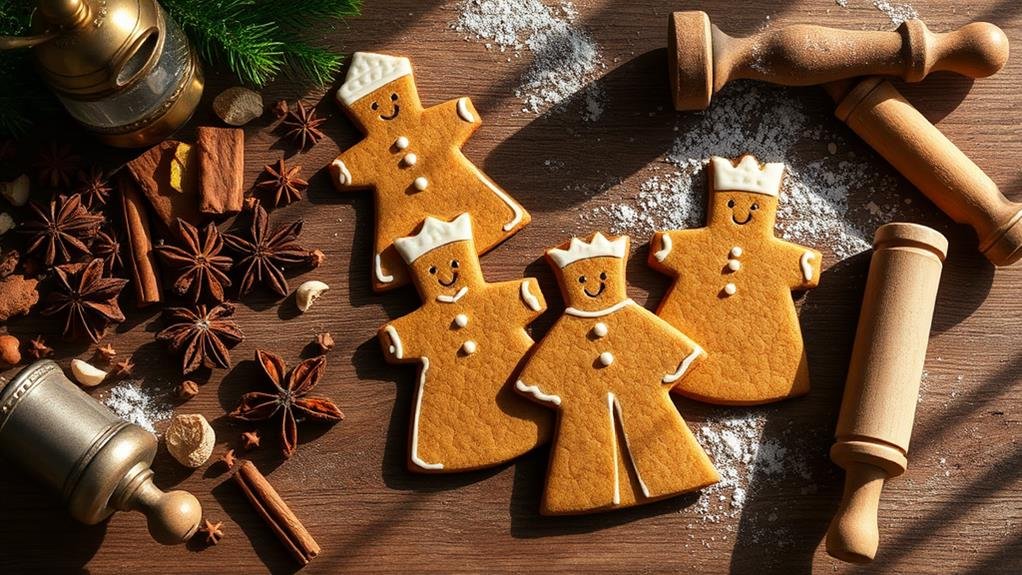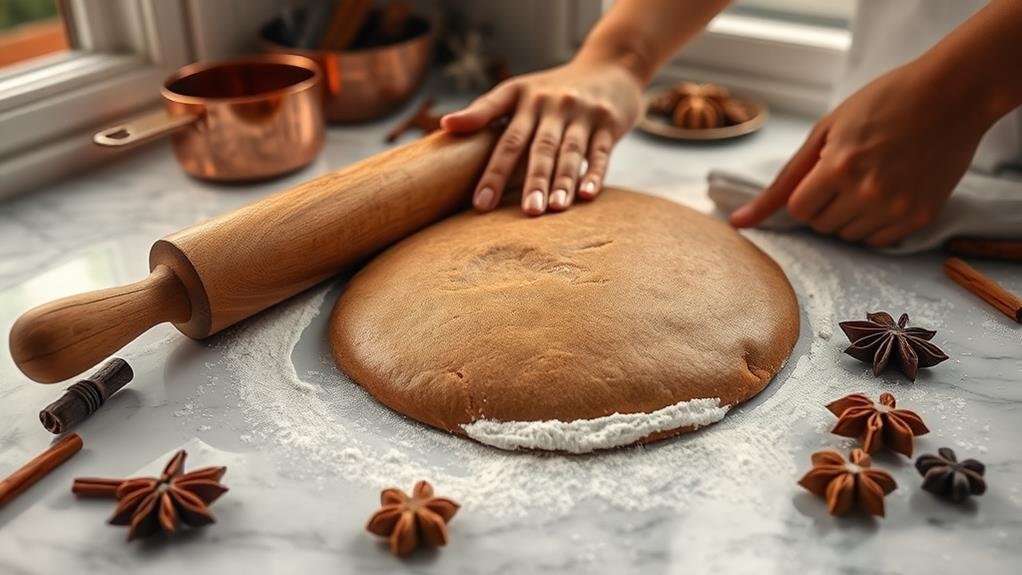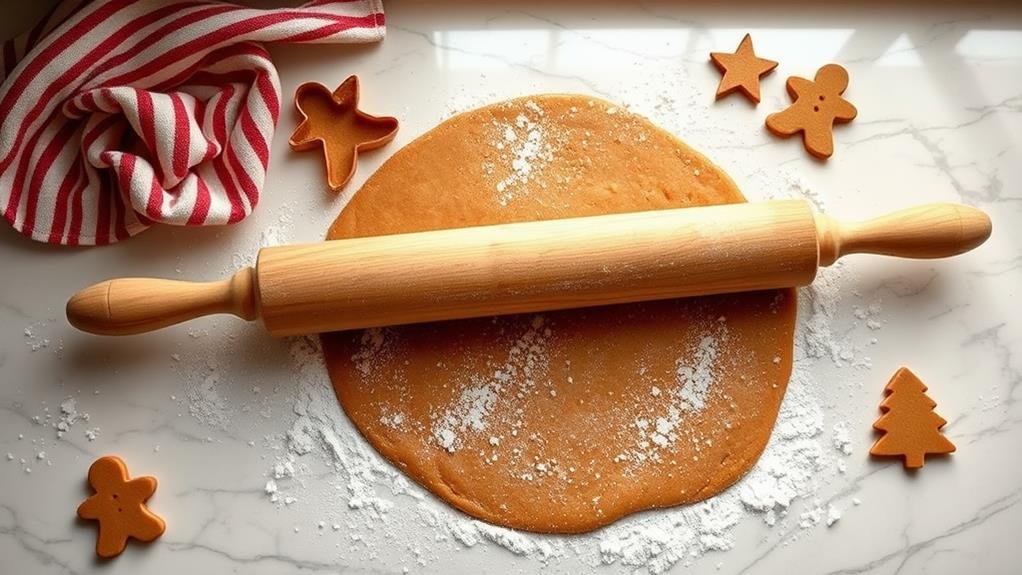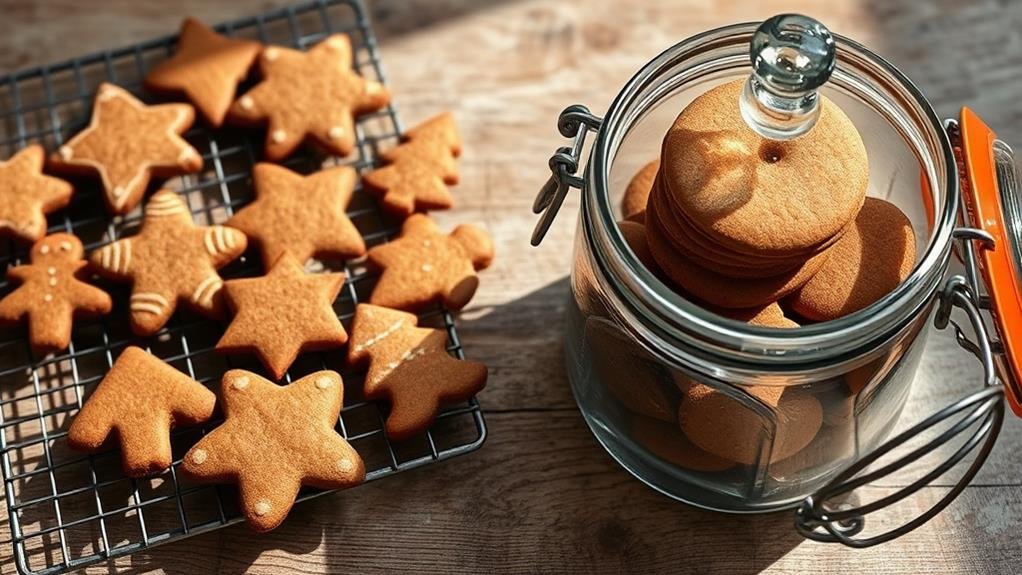For gingerbread cookies that stand up and stay put (unlike my old cat who used to steal them off the cooling rack), you'll want to keep things simple but precise. Just like my grandmother taught me, these aren't fancy-pants cookies – they're good, solid treats that need good, solid ingredients.
First things first – your kitchen shouldn't be too hot or too cold. I learned the hard way that a sweltering kitchen from holiday cooking makes for floppy cookies, and a drafty one makes the dough tough to work with. Room temperature is just right.
Now, measuring is where folks often go wrong. A bit too much here, a little less there, and suddenly your gingerbread men look more like blob monsters. Trust me, I've made that mistake more times than I care to count. You'll want proper measuring cups and spoons – not those novelty ones from the dollar store that are about as accurate as throwing darts blindfolded.
The ingredients matter too. Fresh spices make all the difference – none of that dusty stuff that's been sitting in your cupboard since last Christmas. The molasses and butter need to be good quality. Skimp on these, and you might as well be making cardboard cutouts.
I've been baking these cookies for forty years now, and believe me, getting them right isn't rocket science. It's just about paying attention to the basics and not trying to get too fancy with it.
The History of Gingerbread

The tradition of gingerbread has roots stretching back to Medieval Europe, where skilled bakers crafted elaborate cookies spiced with ginger, cinnamon, and cloves. While early versions were often pressed into intricate molds depicting religious scenes or royal figures, the practice of cutting gingerbread into shapes emerged in 16th century England during Queen Elizabeth I's reign.
The queen reportedly commissioned gingerbread cookies decorated to resemble visiting dignitaries and served them as diplomatic gifts. Today's gingerbread cutout cookies maintain this creative spirit, though they're more likely to take the form of stars, trees, or the classic gingerbread person – a shape that became popular in the early 1800s.
Essential Ingredients and Equipment
A timeless holiday tradition, gingerbread cookies trace their roots back to Medieval Europe, where German monks first crafted these aromatic treats in the 13th century.
The spiced dough, enriched with molasses and warming ginger, quickly spread beyond monastery walls to become a cherished part of Christmas celebrations across continents.
While more elaborate gingerbread houses came later, these simple cutout cookies remain the foundation of festive baking, offering both novice and experienced bakers a reliable canvas for creative decorating.
The recipe produces cookies with the perfect balance of snap and chew, carrying forward a tradition that has delighted generations of holiday revelers.
Tips for Perfect Cookie Dough

The tradition of gingerbread cookies dates back to Medieval Europe, where skilled bakers crafted elaborate designs for festivals and celebrations. These aromatic treats gained particular popularity in Germany, where they became a Christmas market staple and eventually spread across the world as a holiday tradition.
While modern gingerbread cookies are often associated with simple house-building projects and basic shapes, these spice-laden cutouts offer a versatile canvas for both simple and intricate designs. The key to successful gingerbread lies in achieving the perfect balance of structure and flavor – firm enough to hold its shape, yet tender enough to enjoy.
Mixing and Chilling Methods
The tradition of gingerbread cookies dates back to medieval Europe, where skilled bakers crafted intricate designs for festivals and celebrations. While those early versions were often hard enough to preserve for months, modern gingerbread cookies strike a perfect balance between crispness and tenderness.
The key spices – ginger, cinnamon, and cloves – have remained virtually unchanged for centuries, creating that distinctive aroma that signals the arrival of the holiday season. These cutout cookies hold their shape well during baking, making them ideal for everything from simple stars and trees to elaborate house constructions.
Rolling and Cutting Techniques

The tradition of gingerbread cookies dates back to medieval European monasteries, where monks first combined ginger root with sweeteners and spices to create medicinal treats.
By the 16th century, the practice had evolved into an art form, with elaborately decorated cookies becoming popular at festivals and fairs.
German bakers conspicuously shaped these spiced delights into stars, hearts, and human figures – a custom that spread across Europe and eventually to American shores.
Today, the ritual of rolling, cutting, and decorating gingerbread cookies remains a cherished holiday activity, bringing families together and filling homes with the unmistakable aroma of ginger, cinnamon, and molasses.
Baking Your Gingerbread Cookies
The aroma of gingerbread cookies baking in the oven has been a hallmark of winter celebrations since the Medieval period, when crusaders brought ginger and other exotic spices back to Europe from the Middle East.
German bakers in the 16th century refined the art of crafting decorative gingerbread, creating intricate designs and shapes that would eventually inspire the tradition of gingerbread houses and holiday cutout cookies.
While the spice blend and techniques have evolved over centuries, the fundamental appeal of these crisp, warmly-spiced cookies remains unchanged – they're as much a craft project as they're a delicious treat, making them an ideal activity for gatherings during the cold months.
Royal Icing Basics

Royal icing transforms simple gingerbread cookies into edible works of art. This classic decorating technique dates back to the Victorian era, when it earned its "royal" name after being used to adorn Queen Victoria's wedding cake in 1840.
While mixing royal icing requires precision, its ability to dry to a hard, smooth finish makes it the ideal choice for creating intricate designs on holiday cookies.
Unlike buttercream, royal icing can be stored at room temperature and maintains its pristine appearance for weeks, making it particularly valuable for gingerbread houses and holiday gifts.
Creative Decorating Ideas
The tradition of decorating gingerbread cookies dates back to medieval Europe, where skilled artisans crafted elaborate cookie designs for festivals and celebrations. Queen Elizabeth I is credited with the idea of decorating gingerbread figures to resemble visiting dignitaries, setting off a trend that spread throughout England.
Today, transforming simple gingerbread cutouts into festive characters remains a cherished holiday activity, combining the warm, spicy aroma of fresh-baked cookies with the creative satisfaction of personalized decorating. Whether crafting classic holiday shapes or experimenting with modern designs, these sturdy cookies provide the perfect canvas for royal icing, candies, and other edible embellishments.
Storage and Shelf Life

The tradition of gingerbread cookies dates back to medieval Europe, where skilled bakers crafted intricate designs for religious ceremonies and seasonal festivals.
By the 16th century, the practice of making decorative gingerbread figures had spread throughout Germany and England, with Queen Elizabeth I credited for the idea of decorating the cookies to resemble visiting dignitaries.
Today, these spice-laden cookies remain a cherished holiday tradition, filling homes with the unmistakable aroma of ginger, cinnamon, and molasses as families gather to cut, bake, and decorate their own edible masterpieces.
Family-Friendly Holiday Activities
The tradition of gingerbread cookies dates back to Medieval Europe, where skilled bakers crafted elaborate designs for festivals and celebrations. During Victorian times, families began the custom of decorating gingerbread cookies together during the holiday season, a practice that remains popular today.
These spiced cutout cookies deliver the classic combination of molasses, ginger, and warm spices that both children and adults recognize as a hallmark of winter festivities. While the dough requires some patience to chill properly, the reward is crisp edges and soft centers that hold their shape beautifully when baked – making them ideal for decorating with royal icing or simple sugar glaze.

A holiday tradition that spans centuries, gingerbread cookies first appeared in medieval European monasteries, where monks crafted elaborate designs using honey, spices, and breadcrumbs.
By the 16th century, the practice had spread throughout Europe, with German bakers developing the harder, cookie-style gingerbread familiar to us today.
These classic cutout cookies combine warm spices like ginger, cinnamon, and cloves with rich molasses to create that distinctive flavor that signals the arrival of the winter season.
The dough holds its shape well during baking, making it ideal for creating festive shapes that can be decorated with royal icing, candies, or a simple dusting of sugar.
Recipe

The classic gingerbread cookie is a holiday tradition that dates back centuries, combining the warm, aromatic spices of ginger, cinnamon, and cloves with rich molasses and sweet brown sugar. These cookies offer the perfect balance of spicy and sweet flavors while maintaining a texture that's firm enough for decorating yet tender enough to enjoy.
Making gingerbread cutout cookies requires patience and attention to temperature, as the dough needs proper chilling to maintain sharp edges during baking. When properly prepared, these cookies not only taste delicious but also serve as the perfect canvas for holiday decorating, whether creating classic gingerbread people or festive seasonal shapes.
- 3 cups all-purpose flour
- 1½ teaspoons ground ginger
- 1½ teaspoons ground cinnamon
- ¼ teaspoon ground cloves
- ¼ teaspoon ground nutmeg
- ½ teaspoon baking soda
- ¼ teaspoon salt
- ¾ cup unsalted butter, softened
- ¾ cup packed dark brown sugar
- 1 large egg
- ½ cup molasses
- 1 teaspoon vanilla extract
Whisk together the dry ingredients in a medium bowl. In a separate large bowl, cream butter and brown sugar until light and fluffy, about 3 minutes. Beat in egg, molasses, and vanilla until well combined. Gradually mix in dry ingredients until a dough forms. Divide dough in half, wrap in plastic, and refrigerate for at least 2 hours or overnight. Roll out dough on a floured surface to ¼-inch thickness, cut with desired cookie cutters, and place on parchment-lined baking sheets. Bake at 350°F for 8-10 minutes until edges are lightly browned.
For best results, maintain the dough remains chilled while working with it, as warm dough becomes sticky and difficult to handle. If decorating with royal icing, allow cookies to cool completely before applying. Store cookies in an airtight container at room temperature for up to one week, or freeze undecorated cookies for up to three months.
Conclusion
Don't let anyone tell you gingerbread cookies are fussy – they're really not! Just keep your dough nice and cold in the fridge (around 40°F works best), and roll it out to about the thickness of your pinky finger – that's roughly 1/4 inch. A decent oven thermometer helps too, since ovens can be a bit temperamental. I've been making these for over 40 years, and let me tell you, once you get the hang of it, you'll be turning out perfect cookies with clean edges and that wonderful spicy aroma that fills the whole house. No need to get too caught up in precise measurements – your hands know what feels right after a while. Just keep the dough chilled, roll it evenly, and you'll do fine.

